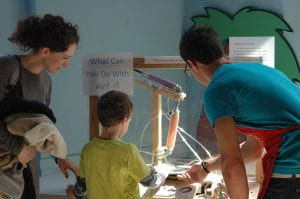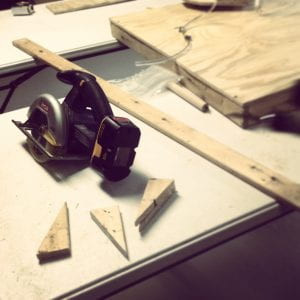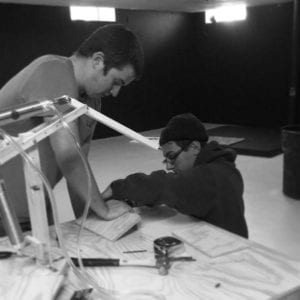Weeks 6 and 7: Final steps!
Last week started with a trip to the CMTM to test out the arm in their museum as well. We drove up on Sunday night and stayed at a hotel. It was a ton of fun to bond as a group and get to see a little more of Portland before spending the next day in the museum.
We started off our testing in a closed off room which they normally use as a theatre and only got one kid to come in to test, so we moved to the main floor where the whale exhibit normally is. We had a lot more foot traffic there and much more success testing!!! Next we moved to the front room where the museum has their most popular ball exhibit and right in the front of the museum, but we had less people there to test it since there was a program going on. After a long few hours of testing we took a break for lunch and thought about the day. When we got back to the museum we discussed the successes and failures of the day and were able to come up with our last few steps for our project! Talking with Chris has given us a new view on our project and we are so proud of what we have to offer the CMTM when we are done with our final changes!!!
The week wrapped up with two busy trips to the EcoTarium. Since it was school vacation in Worcester and the EcoTarium was hosting an Earth Day event, there were plenty of families around. We even had a line for a while family waiting to try the new exhibit. It was very rewarding to see so many children enjoy and understand the arm. It is so rewarding to see our project become so successful! We know there is still work to be done, but we will be leaving the CMTM with our conclusions and recommendations for the continuation of prototyping. We hope to visit the arm in its new home and see its success!
Week 5: Continued Game Development and Refinement, April 12, 2013
This past week’s prototyping yielded more great results! Not only did the games work well but Chris loved the direction in which we are going. We developed two games, a tic-tac-toe game and a recycling game. The tic-tac-toe game kept kids engaged for a long time and worked fantastically. The recycling game simply tasked the children with picking up tuna cans and placing them into a recycling bin. While the recycling game was not as open ended as the tic-tac-toe game, it worked great nonetheless. so going forward we are going to make the tic tack toe game stronger and more robust so that it can possibly be incorporated into the final exhibit.
More parts for our final compressor set up arrived so we needed to make another field trip to Air Inc. in Franklin, MA. There we purchased a regulator to drop the pressure down from 90-120 psi to the operating pressure of 5-20 psi. We also purchased more fittings and tubing. We now have more tubing than anyone could ever need!
One final step in the refinement of the user interface was also taken this past week. We built a system to keep the levers in the off position unless the user is holding them in the go position. After this change we believe we are very close to being finished with the development of the user interface.
On Sunday afternoon we will be heading up to Portland, ME to test at The Children’s Museum and Theatre of Maine to test what we have built with our primary sponsor. We booked 2 hotel rooms up there so we don’t have to make the 2+ hour commute at the crack of dawn with commuter traffic. We are extremely excited to show Chris what we have accomplished. More updates to follow!
Week 4: Game Development, April 5, 2013
This week we continued prototyping and started working on game development! After 3 rounds of testing at the EcoTarium, focusing on the interface and usability of the arm, we are happy to report that our interface is making good progress. There are still several changes we intend to make to try to make things more user friendly, however with parental guidance the current system is fully functional.
We talked with Chris Sullivan, our sponsor, from the CMTM this week and decided that the arm not only has to be functional, but the way in which the arm works must cause children to become inquisitive. The objective of the exhibit is to inspire children so we must make the process of its operation as evident as we can. We decided the best way to do this was to insert a ball or string into the tubes to highlight and draw attention to the movement of air which drives the pistons.
Once we decided we had a solid handle on the interface development, we started working on the game that the arm would be used for. After brainstorming and trying out multiple ideas, we decided on two games to try as an initial test. The first game, most children know, is tic-tac-toe. The X and O pieces were made out of colorful construction paper and washers. The second game we decided to try was putting metal cans into a recycle bucket. This is a relatively simple task for young children to accomplish and still teaches them multiple lessons.
Once these games were developed and discussed with our sponsor, it was time to test again! We started out the day with our new labels and the tic-tac-toe game. You can see the game in our first picture of the day! Besides testing which game was easier for the kids, we also tested the impact of color coding the pistons with their matching controls. We originally tried black and white for the color coding, but they didn’t grab enough attention. We then swapped to purple and orange colors which were much more noticeable and the kids were able to figure out which handle connected to which part of the arm.
Our next steps are to make the changes from our testing observations and conversations with our sponsor. Some of these changes are controlling the levers with springs so they are held in the off position and the arm will only move when the child actively pushes the levers into the up or down positions. Another interface modification we are going to try is to change our interface panel so it isn’t on an angle, but is actually vertical. This means the lever positioning will be moving up and down instead of side to side. The last change we plan to make is to the tubes as suggested by Chris and we hope these changes get the children’s minds churning!
Week 3: Testing, March 29, 2013
We had our first round of prototyping last week! It didn’t go as well as planned, but we were definitely able to collect some useful feedback! As expected, the arm was hard to control due to the nature of pneumatics. So, after a morning of researching solutions and trying out different ways to fix the problem, we figured out we would need some new hardware. A wild goose chase ensued! By wild goose chase we mean we drove around Worcester for 4 hours checking out various industrial suppliers (whom we had called) to see if they had the part we needed (which they said they did). Turns out, they didn’t! The problem we came across was the major difference between pneumatics (pressurized air) vs. hydraulics (pressurized liquid). Hydraulics run at much higher pressures than pneumatics so the parts available to us were too strong and too expensive for our purposes.

Eventually, we were given the name of a pneumatics company called Air Incorporated based out of Franklin, MA. They had the exact part we needed and at an affordable price! YAY!! They also were nice enough to give us sample tubing and new fittings to fit the new tubing for free. Once we got the new parts, we rebuilt the arm and it worked exactly as we had intended. The movement was much more fluid and easier to control so we decided to prototype at the EcoTarium again.
The second round of prototyping went well, but was not without its own set of problems. This time, we had a larger age range of children use the arm. The youngest was as young as 18 months and the oldest was 7 years old. We noticed that clearly the younger kids, typically less than 3 or 4, had little to no understanding or interest in the control of the arm. They simply pulled the levers back and forth and often did not even watch the arm, this was rather heartbreaking to think the arm was so disinteresting to them. : (. The older kids were able to control the arm and with practice, move it as they pleased. This was great to see!
Week 2: Second Steps, March 22, 2013
On top of our weekly Skype meeting with our sponsor Chris from the CMTM, we were also able to see Betsy our contact at the EcoTarium on Tuesday. We showed her our robotic arm as it was and got her feedback on what we still needed to do before bringing it out on the floor to test. She gave us tons of useful feedback on safety as well as things to look for when we start testing. The most shocking piece of information she gave us was that most people do not think of magnets as something that can be turned on or off, they are imagined as always on! After all this useful information, the team prepared for our first test run at the museum by determining several things we are going to focus on for out first trials.
Once we had everything all put together we had to make sure it was safe for children’s usage. Much duct tape was used in the building of this exhibit. We covered all the sharp parts with duct tape and made the lazy Susan into what looks like a steering wheel so the kids will know to turn it. We also set up a removable polycarbonate front enclosure so if anything goes wrong the kids will be safe.
We went to P&A Sales in Worcester to buy a sheet of plastic to make a front display. P&A Sales specializes in exhibit and display production so that was perfect for us! The guys there were extremely nice and helpful.
The plastic is also almost impossible to cut. Our initial plan was to laser cut the piece to match our design specs. This was done by John creating a 3D model and drawing which had the appropriate dimensions.
Once we reached the lab we found out that the laser cutter was too small to fit our 3 foot by 3 foot piece of polycarbonate. We then decided to use the bandsaw in the Washburn shops to accomplish the job. The lab monitor showed Jerrod and Katelyn how to use the bandsaw and the two of them accurately used the machine to cut out the desired piece.
Through recommendations from both Chris and Betsy, we will be firstly focusing on the interface. We plan to test it as is and then see if adding colors or diagrams make it easier for users to understand. We are all very excited for our first test run on Friday morning in the actual museum!!! We will be at the museum half an hour before they open in order to set up in our new location next to the stairs so that our compressor can be buried under the stairs to muffle its loud noise.keep the volume down a little.
Now that we have our first stage prototype, we are looking forward to a full week of testing!!
Note to self: DO NOT BELIEVE THE TRANSFER PAPER. WPI is now down two printers on the second floor because of wrong information on the packaging for the transfer paper we were going to use to make T-shirts. The help desk was pretty sure it would work and so we tried it. We were all wrong. The laser printer actually melts the adhesive and therefore gets stuck in the printer and then creating a big mess. JUST USE THE PRINTER AT HOME!
Week 1: First Impressions, March 15, 2013
Welcome to our first blog for our first week of IQP! This week we are very proud of our success in a few specific tasks. At the begining of the week once we got situated in the Project Center, we started looking at the robotic arm we got from our sponsor at the CMTM, Chris Sullivan, and decided what we wanted to change. We had a big to do list assembled by the end of the day, but we were all really excited to get building after thinking up ideas to make it spectacular for almost two months now!
Before we could get started however, we had to fix our IRB application. Ourproject works with children so the IRB needed more information on our projct and what we intended to do before they would approve us. For the expeditited review we had to send in more detail on our methods section as well as write up informative scripts to use when testing. It was decided that writen consent was not needed, but verbal consent was in order to observe and record notes on what the children and adults did with the prototype exhibit. Finally we were approved by the IRB on Thursday afternoon.
Firstly, we needed to find a way to make the magnet at the end of the robotic arm turn on and off with ease in a way that children would easily understand. After purchasing a voltage converter, we wired the electromagnet to a light switch that could then be plugged into a normal outlet. Once we got this working we were very excited for all of the possible games that we could use this magnet for in the robotic arm exhibit and started continuing our list of all the possibilities! It was very exciting for us, once the magnet was working since none of us had really had much prior experiance with electronics.
Another exciting milestone for the week was our Skype meeting with our sponsor, Chris Sullivan. This got us ready for the upcoming term. We need a compressor for the robotic arm to work so we discussed the options with Chris and now have one ordered and will be able to test at the EcoTarium when that arrives.
Wednesday, Thursday, and Friday we kicked it into high gear on the building front after getting the go-ahead from Chris. We built a rotating base for the arm and worked on the pneumatics after a few trips to Home Depot for parts. We are so excited to test it out next week now that its functional!
Our final roadblock that was discovered this week is that we need a good compressor. The compressor we used for testing and trial runs is a tire compressor from Audrey’s basement, which is loud and has too much pressure. After discussing with our sponsor, he has found a smaller compressor and air tank combination that is much more suited to the museum environment.
See the video below to see our first sucessful trial run!







